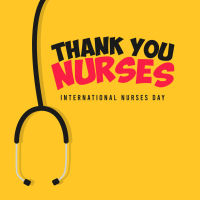7 April is World Health Day, and this International Year of the Nurse and the Midwife it celebrates the work of nurses and midwives and their critical role in keeping the world healthy with the tagline 'Support nurses and midwives.' To mark this day, the World Health Organization has released the first ever State of the World’s Nursing 2020 Report.
You may also like: Internationally Educated Nurses: Pros and Cons
191 countries provided data for the report, an all-time high. Of those, around 80% reported on 15 indicators or more.
The nursing workforce is expanding in size and professional
scope being the largest occupational group in the health sector – 27.9 million
globally, or approximately 59% of the health professions. They include 19.3
million (69%) professional nurses, 6.0 million (22%) associate professional
nurses and 2.6 million (9%) who are not classified either way.
The substantial shortage of nurses persists on a global
scale, although it had decreased slightly from 6.6 million in 2016 to 5.9
million in 2018. Almost 90% of that shortage is concentrated in low- and lower
middle-income countries.
Density of nursing personnel per 10,000 population in 2018. Source: State of the World’s Nursing 2020. Executive Summary.
Another emerging issue is ageing health workforce, especially in the American and European regions. Finding the balance between the age groups is a priority. Countries with larger share of nurses aged 55 years and over should increase graduate numbers and strengthen retention packages. The ones with early career workforce (under 35 years old) prevalent should enhance their equitable distribution across the country.
According to the report, by 2030 the shortage may have
reached 5.7 million nursing personnel, primarily in the African, South-East
Asia and Eastern Mediterranean regions. To prevent this, all countries would
need to increase the total number of nurse graduates by 8% per year on average,
while improving employment and retaining policies. This includes revising
approaches to education, training and accreditation as well as expanding the
scope of advanced practice roles for nurses and adjusting the regulation of
nursing profession.
The data also indicate that nursing remains a highly
gendered profession. Despite 90% of the nursing workforce being female, this is
not reflected in leadership, and there is evidence of gender-based
discrimination in the work environment including pay gaps.
To address current and future challenges, ten key actions
are suggested in the report.
1) Increase in funding to educate and employ additional nurses. In most countries this can be achieved with domestic funds, while low- and low middle-income countries should consider external assistance.
2) Strengthening capacity for health workforce data collection, analysis and use (including the implementation of National Health Workforce Accounts) to guide policy development and investment decisions.
3) Monitoring and management of nurse mobility and migration, including through implementation of the WHO Global Code of Practice on the International Recruitment of Health Personnel. Overreliance on migrant nurses should be addressed by investing more in domestic nursing workforce.
4) Readjustment of nurse education and training programmes in such a way so that nursing becomes a career choice grounded in science, technology, teamwork and health equity.
5) Enhanced nursing leadership and governance through strengthening the role of a senior nurse in the government and implementation of leadership programmes.
6) The contributions of nursing practice should be optimised to ensure that nurses are working to their full scope of practice, and efficient nurse-led models of care and workplace policies are in place.
7) Enabling work environment for nursing staff should be supported at all levels with improved attraction, deployment, retention and motivation policies.
8) Countries should deliberately plan for gender-sensitive nursing workforce policies across the education, practice, regulatory and leadership functions.
9) Professional nursing regulation must be modernised through harmonisation of nursing education and accreditation standards, and introduction of interoperable systems for simplified data verification.
10) Collaboration is key between all the stakeholders including various authorities, private sector, educational institutions, professional nursing associations and global initiative among others.
This report concludes with recommendations to national governments to:
- Build leadership, stewardship and management capacity for the nursing workforce to advance the relevant education, health, employment and gender agendas.
- Optimise return on current investments in nursing through adoption of required policy options in education, decent work, fair remuneration, deployment, practice, productivity, regulation and retention of the nursing workforce.
- Accelerate and sustain additional investment in nursing education, skills and jobs.
It is stressed that additional investments are necessary,
but the returns for societies and economies would be invaluable in terms of
improved health outcomes, employment opportunities and enhanced global health
security.
The full report and executive summaries are available here.
Source: WHO
Image credit: WHO



























